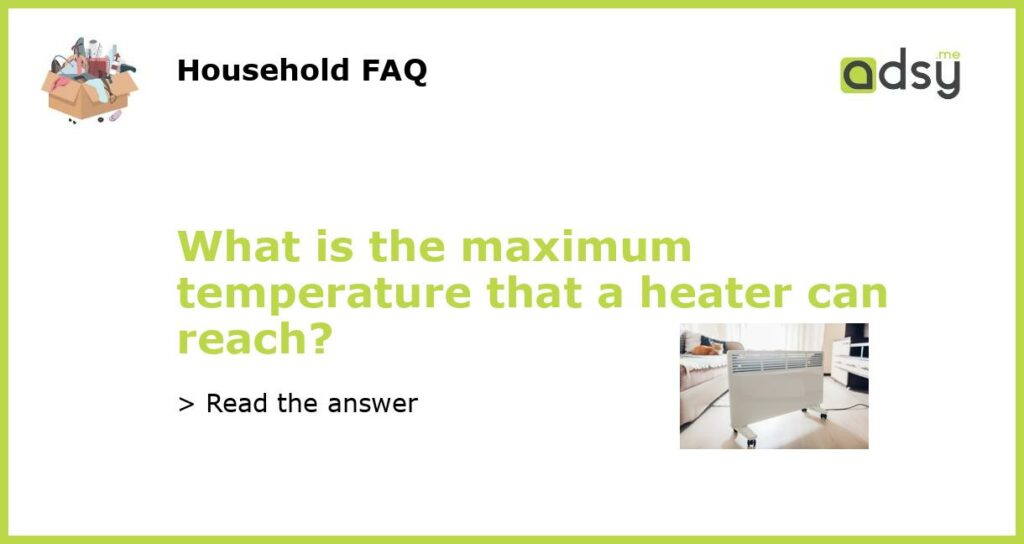The Maximum Temperature that a Heater Can Reach
If you are considering purchasing a heater, one of the main factors you may want to know is its maximum temperature capability. The maximum temperature that a heater can reach depends on several factors, including the type of heater, its design, and the specific model. In this article, we will provide an overview of the maximum temperature capabilities of different types of heaters.
Heating Systems
Heating systems, such as furnaces and central heating systems, are typically designed to reach a maximum temperature of around 120-130 degrees Fahrenheit (48-54 degrees Celsius). This temperature range is considered safe for residential use and provides sufficient warmth for most households. However, it is important to note that the actual temperature output can vary depending on the size and efficiency of the heating system.
It is recommended to consult the manufacturer’s specifications and guidelines to determine the maximum temperature capability of your specific heating system. Additionally, it is important to ensure that your heating system is properly installed, maintained, and operated to avoid any safety hazards or damage to the system.
Portable Space Heaters
Portable space heaters are popular for providing supplementary heat in specific areas of a room or for heating small spaces. The maximum temperature that a portable space heater can reach varies depending on its design, size, and heating technology.
Some portable space heaters, such as ceramic heaters, can reach maximum temperatures of up to 150-160 degrees Fahrenheit (66-71 degrees Celsius). These heaters use ceramic elements or plates to generate heat, and they are often equipped with safety features to prevent overheating and burns.
Other types of portable heaters, such as oil-filled radiators or infrared heaters, typically have lower maximum temperature capabilities. Oil-filled radiators generally reach maximum temperatures of around 140-150 degrees Fahrenheit (60-66 degrees Celsius), while infrared heaters can reach temperatures of approximately 120-140 degrees Fahrenheit (48-60 degrees Celsius).
Electric Baseboard Heaters
Electric baseboard heaters are commonly used for zone heating and can be installed underneath windows or along the base of walls. These heaters typically have a lower maximum temperature capability compared to heating systems or portable space heaters.
The maximum temperature that an electric baseboard heater can reach typically ranges from 120-150 degrees Fahrenheit (48-66 degrees Celsius). It is important to note that electric baseboard heaters distribute heat through natural convection, which means that the temperature may vary depending on the room’s size, insulation, and other environmental factors.
Industrial and Commercial Heaters
Industrial and commercial heaters are designed to meet the specific heating needs of large spaces, such as warehouses, factories, or commercial buildings. These heaters often have higher maximum temperature capabilities compared to residential heaters.
The maximum temperature that an industrial or commercial heater can reach depends on the specific application and heating technology used. For example, infrared radiant heaters can reach temperatures of up to 1600 degrees Fahrenheit (871 degrees Celsius), while industrial electric heaters or gas-fired heaters can reach temperatures of several hundred degrees Fahrenheit.
It is crucial to consult the manufacturer’s specifications and guidelines when considering industrial or commercial heaters, as they require professional installation and proper ventilation to ensure safety and optimal performance.
Safety Considerations
When using any type of heater, it is important to prioritize safety precautions to prevent accidents, burns, or fires. Here are some general safety tips to keep in mind:
- Keep flammable materials away from heaters to avoid the risk of fire.
- Do not leave heaters unattended, and make sure to turn them off when not in use.
- Ensure proper ventilation to prevent the buildup of carbon monoxide or other potentially harmful gases.
- Follow the manufacturer’s instructions for installation, operation, and maintenance.
- Regularly inspect heaters for any damages or malfunctions.
By following these safety guidelines and understanding the maximum temperature capabilities of different types of heaters, you can choose the most suitable option for your heating needs while ensuring the safety of your household or workspace.






